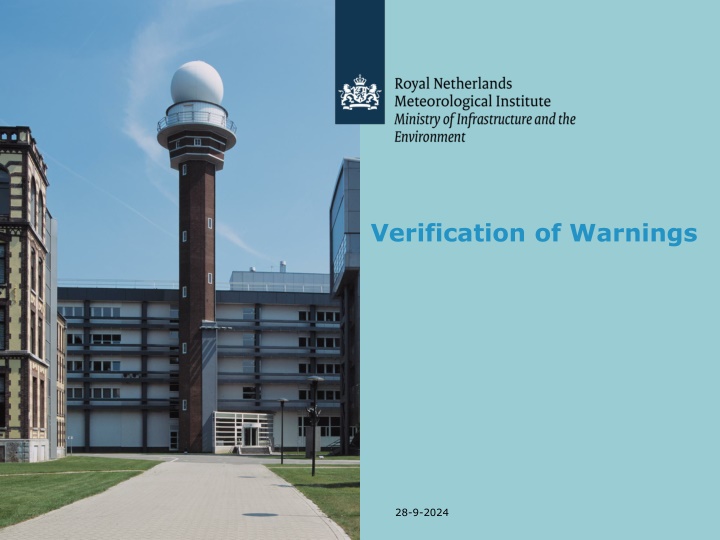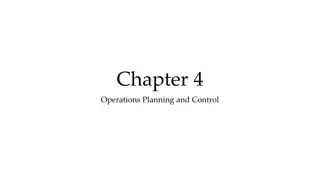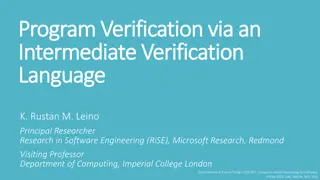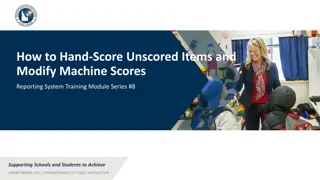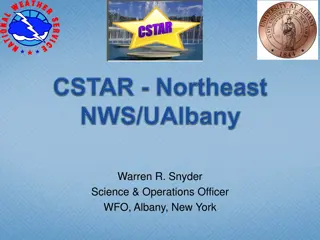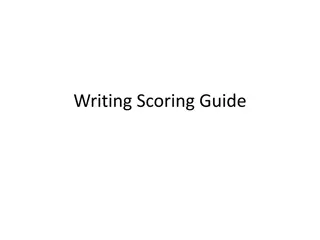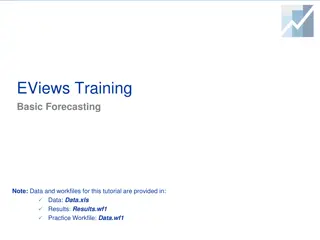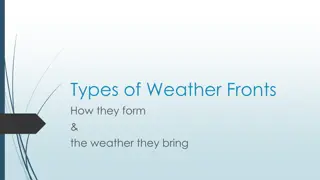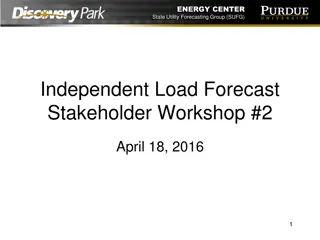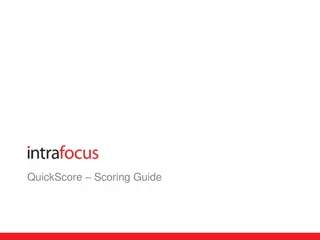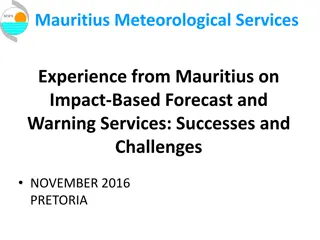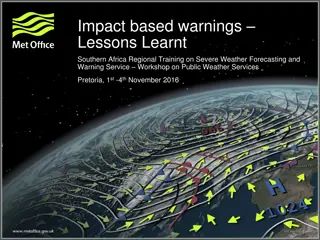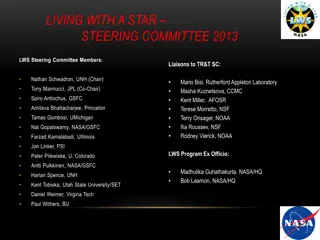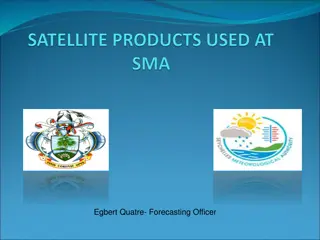Warning Verification and Scoring Guidelines in Weather Forecasting Workshop
Learn about the verification of warnings, classical contingency scoring, false alarm ratio, hits, false alarms, missed alarms balance, threshold-based warning verification, and impact-based warning verification discussed in the IMS Warning workshop at KNMI Block III. Understand the importance of maintaining a balance between hits and false alarms to ensure the credibility of your warning system.
Download Presentation

Please find below an Image/Link to download the presentation.
The content on the website is provided AS IS for your information and personal use only. It may not be sold, licensed, or shared on other websites without obtaining consent from the author.If you encounter any issues during the download, it is possible that the publisher has removed the file from their server.
You are allowed to download the files provided on this website for personal or commercial use, subject to the condition that they are used lawfully. All files are the property of their respective owners.
The content on the website is provided AS IS for your information and personal use only. It may not be sold, licensed, or shared on other websites without obtaining consent from the author.
E N D
Presentation Transcript
Verification of Warnings 28-9-2024
Warning Verification subjects Hits, False Alarms and Missed Alarms in balance Classical Warning verification against thresholds Impact based Warning Verification IMS Warning workshop KNMI - Block III 28-9-2024
Classical Contingency scoring table IMS Warning workshop KNMI - Block III 28-9-2024
False Alarm Ratio (FAR) https://www.wmo.int/pages/prog/www/.../Doc-7-Verification.doc 2.3.2 False Alarm Ratio (FAR) The false alarm ratio is the ratio of the total false alarms (b) to the total events FORECAST (a+b). Its range is 0 to 1 and a perfect score is 0. It does not include c and therefore is not sensitive to missed events. One can improve the FAR by systematically underforecasting rare events. It also is an incomplete score and should be used in connection with the HR above. 2.3.4 Threat Score (Critical success index) The critical success index is frequently used as a standard verification measure, for example in the U.S.A. It has a range of 0 to 1 with a value of 1 indicating a perfect score. The CSI is more complete than the HR and FAR since it is sensitive to both missed events and false alarms. IMS Warning workshop KNMI - Block III 28-9-2024
Hits, False and Missed Alarms in balance You should allow your warning system to have false alarms If you don t allow false alarms, you will almost automatically increase the number of missed alarms A missed alarm is the main reason for much internal and external criticism towards your NMHS. Also too many false alarms will devaluate the credibility of your warning system Your hit ratio especially for Orange and Red should best be between 80 to 90 %, the false alarm ratio should not be above 10 to 20% IMS Warning workshop KNMI - Block III 28-9-2024
Threshold based warning verification Verification should be done by checking on: 1. Was the warning issuing threshold reached 2. Was the threshold reached within the region indicated in the warning and during the validity period of this warning 3. You can hopefully check this out of your observational database, synops and metars and other official national observations At the end you could score your warning as a hit or false alarm. Do not forget the missed alarms ! This scoring at times is to strict, so you could also score 1,2,3 by classifying it in Excellent / Good / Poor / Very poor IMS Warning workshop KNMI - Block III 28-9-2024
Impact based warning verification If you issue Impact based warnings you best verify your warnings against the occurred impact If your warning system is based on implicit impact criteria, such as return period based thresholds, or on a combination out of explicitly impact driven criteria together with return period based thresholds you better do both verification paths. So impact based verification next to classical meteorological threshold reached verification IMS Warning workshop KNMI - Block III 28-9-2024
Impact based warning verification Recommendation on Impact based warning verification (WMO TTWarn) Impact based warnings should contain information on: What level of impacts to expect (+ Impact and Advisory information) Over what period these impacts will occur In what area those impacts will happen So after the event the verification should focus on these 3 topics: 1. 2. 3. Level of occurred impact correctly forecasted ? Was the time period of the predicted impact correct ? Was the location, or region, of the affected area correct ? IMS Warning workshop KNMI - Block III 28-9-2024
Impact based warning verification 1. What were the impacts ? In this part of the verification scheme it is necessary to decide whether the impacts that happened match those that were forecasted in the warning. 2. When did the impacts happen ? Did the impacts occur during the validity period of the warning? Was the warning issued sufficiently far ahead of the event so preparations could be made? 3. Where did the impacts occur ? Did the impacts occur in the area indicated by the warning? IMS Warning workshop KNMI - Block III 28-9-2024
Impact based warning verification In order to do 1, 2, and 3 it is important to look outside of your NMHS and use a variety of sources. These could include: Media reports national and local TV and radio, press reports, social media etc. Reports and feedback from Civil Protection Agencies Reports from other Government departments Public reports, reports into the NMS, WOW reports Public surveys after the event IMS Warning workshop KNMI - Block III 28-9-2024
Impact based warning verification Each of these three aspects can be assessed and then the warning can be categorised into one of four categories: a. Excellent warning provided excellent guidance to the user b. Good warning provided good guidance to the user c. Poor warning provided poor guidance to the user d. Very Poor warning provided poor guidance to the user (this could include a missed warning or a false alarm) It is worth bearing in mind that if an impact based warning is working, then the impacts that occur may be lower than they might have been if there were no warning in force as the population may have taken action to mitigate against those impacts. There will therefore always have to be a degree of pragmatism and flexibility in any verification scheme. IMS Warning workshop KNMI - Block III 28-9-2024
Impact based warning verification Missed events If at least medium impacts occur over a reasonably sized geographical area and no warning has been issued, a Met Service should also make a note of these events and mark them as missed events, so very poor guidance in any verification scheme Ensuring robustness of a subjective verification scheme A Met Service could consider holding a monthly meeting or teleconference to discuss the warnings that have been issued, and how they have verified. This discussion could include other forecasters, other departments within the Met Service, members of the Civil Protection community and representatives from Government Departments IMS Warning workshop KNMI - Block III 28-9-2024
IMS Warning workshop KNMI - Block III 28-9-2024
